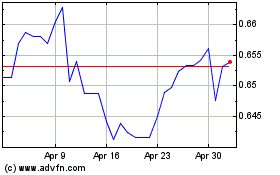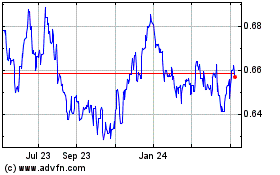Antipodean Currencies Rise Amid Rising Risk Appetite
November 30 2015 - 6:34PM
RTTF2
Antipodean currencies such as the Australian and the New Zealand
dollars strengthened against their major counterparts in the Asian
session on Tuesday amid rising risk appetite, as investors went
bargain hunting ahead of crucial data due later in the week.
The IMF report released on Monday on yuan's inclusion in the SDR
basked of currencies also supported the Asian market.
The Australian and the New Zealand dollars rose after official
data showed mixed private sector activity data. While manufacturing
activity contracted at a steeper pace in November than in the
previous month, falling to a 3-year low, the service sector
activity accelerated.
Meanwhile, Markit/Caixin's manufacturing PMI for China was
upwardly revised to 48.6.
The Australian dollar changed little after the RBA rate
decision. The Reserve Bank of Australia decided to maintain its
interest rate at 2.00 percent, as expected by the economists.
A report released by the Australian Bureau of Statistics showed
that the total number of building approvals rose more than expected
in October to the previous month.
The Australian Bureau of Statistics also showed that Australia
had a current account deficit of A$18.104 billion in the third
quarter of 2015. That missed forecasts for a shortfall of A$16.5
billion, but was up from the downwardly revised A$20.5 billion
deficit in the second quarter.
Traders now await the European Central Bank's monetary policy
meeting on Thursday, with many expecting the bank to provide
further stimulus. Meanwhile, traders bet that the U.S. jobs data
due this week is likely to support a Fed rate hike from near zero.
The Federal Reserves Monetary Policy Committee is set to meet on
December 15-16.
Monday, the Australian and the New Zealand dollars showed mixed
performance against their major rivals. While the aussie and the
kiwi fell against the U.S. dollar, they rose against the yen and
the euro.
In the Asian trading, the Australian dollar rose to nearly a
5-month high of 1.4555 against the euro, nearly a 4-month high of
0.9692 against the Canadian dollar and nearly a 3-1/2-month high of
89.46 against the yen, from yesterday's closing quotes of 1.4614,
0.9655 and 88.96, respectively. If the aussie extends its uptrend,
it is likely to find resistance around 1.44 against the euro, 0.97
against the loonie and 92.00 against the yen.
Against the U.S. dollar, the aussie advanced to a 1-week high of
0.7266 from yesterday's closing value of 0.7226. The aussie is
likely to find resistance around the 0.73 area.
The NZ dollar rose to nearly a 6-month high of 1.5931 against
the euro and more than a 4-week high of 81.71 against the yen, from
yesterday's closing quotes of 1.6037 and 80.99, respectively. If
the kiwi extends its uptrend, it is likely to find resistance
around 1.56 against the euro and 83.00 against the yen.
Against the U.S. and the Australian dollars, the kiwi advanced
to nearly a 4-week high of 0.6637 and nearly a 2-week high of
1.0936 from yesterday's closing quotes of 0.6580 and 1.0973,
respectively. The kiwi may test resistance near 0.68 against the
greenback and 1.07 against the aussie.
Meanwhile, the safe-haven U.S. dollar fell against its major
rivals.
The U.S. dollar fell to 4-day lows of 1.0597 against the euro
and 1.5097 against the pound, from yesterday's closing quotes of
1.0563 and 1.5055, respectively. If the greenback extends its
downtrend, it is likely to find support around 1.08 against the
euro and 1.52 against the pound.
Against the yen, the Swiss franc and the Canadian dollar, the
greenback edged down to 122.81, 1.0263 and 1.3326 from yesterday's
closing quotes of 123.09, 1.0288 and 1.3361, respectively. The
greenback may test resistance near 121.00 against the yen, 1.01
against the franc and 1.32 against the loonie.
Looking ahead, Swiss GDP data for the third quarter and Bank of
England's financial stability report, along with bank stress-test
results are due to be released in the pre-European session at 1:45
am ET and 2:00 am ET, respectively.
Swiss retail sales data for October, final manufacturing PMI
reports from major European economies for November, German
unemployment rate for November and Eurozone unemployment rate for
October are due later in the day.
At 4:00 am ET, Bank of England Governor Mark Carney holds a
press conference on the Financial Stability Report and the U.K.
Bank Stress Tests in London.
In the New York session, Canada GDP data for September, Canada
RBC manufacturing PMI for November, U.S. construction spending data
for October and ISM U.S. manufacturing PMI for November are slated
for release.
At 12:45 pm ET, Federal Reserve Bank of Chicago President
Charles Evans is expected to speak about the economic outlook and
monetary policy at the Lansing Regional Chamber of Commerce in East
Lansing.
AUD vs US Dollar (FX:AUDUSD)
Forex Chart
From Aug 2024 to Sep 2024

AUD vs US Dollar (FX:AUDUSD)
Forex Chart
From Sep 2023 to Sep 2024
